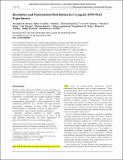Resolution and Polarization Distribution in Cryogenic DNP/MAS Experiments
Author(s)
Barnes, Alexander; Corzilius, Bjorn; Mak-Jurkauskas, Melody L.; Andreas, Loren; Bajaj, Vikram S.; Matsuki, Yoh; Belenky, Marina; Lugtenburg, Johan; Sirigiri, Jagadishwar R.; Herzfeld, Judith; Griffin, Robert Guy; Temkin, Richard J; ... Show more Show less
DownloadBarnes_PCCP_r4_JH copy.pdf (1004.Kb)
OPEN_ACCESS_POLICY
Open Access Policy
Creative Commons Attribution-Noncommercial-Share Alike
Terms of use
Metadata
Show full item recordAbstract
This contribution addresses four potential misconceptions associated with high-resolution dynamic nuclear polarization/magic angle spinning (DNP/MAS) experiments. First, spectral resolution is not generally compromised at the cryogenic temperatures at which DNP experiments are performed. As we demonstrate at a modest field of 9 T (380 MHz [superscript 1]H), 1 ppm linewidths are observed in DNP/MAS spectra of a membrane protein in its native lipid bilayer, and <0.4 ppm linewidths are reported in a crystalline peptide at 85 K. Second, we address the concerns about paramagnetic broadening in DNP/MAS spectra of proteins by demonstrating that the exogenous radical polarizing agents utilized for DNP are distributed in the sample in such a manner as to avoid paramagnetic broadening and thus maintain full spectral resolution. Third, the enhanced polarization is not localized around the polarizing agent, but rather is effectively and uniformly dispersed throughout the sample, even in the case of membrane proteins. Fourth, the distribution of polarization from the electron spins mediated via spin diffusion between [superscript 1]H–[superscript 1]H strongly dipolar coupled spins is so rapid that shorter magnetization recovery periods between signal averaging transients can be utilized in DNP/MAS experiments than in typical experiments performed at ambient temperature.
Date issued
2010-05Department
Massachusetts Institute of Technology. Department of Chemistry; Massachusetts Institute of Technology. Department of Physics; Massachusetts Institute of Technology. Plasma Science and Fusion Center; Francis Bitter Magnet Laboratory (Massachusetts Institute of Technology)Journal
Physical Chemistry Chemical Physics
Publisher
Royal Society of Chemistry, The
Citation
Barnes, Alexander B. et al. “Resolution and Polarization Distribution in Cryogenic DNP/MAS Experiments.” Physical Chemistry Chemical Physics 12.22 (2010): 5861.
Version: Author's final manuscript
ISSN
1463-9076
1463-9084